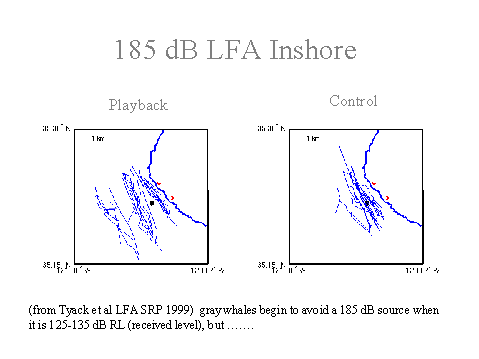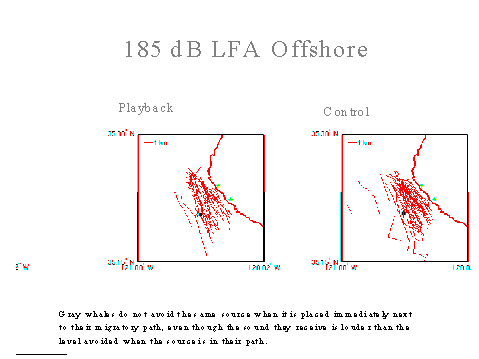Robert C. Gisiner- gisiner@onr.navy.mil
Office of Naval Research, BCT-1, Code 342, 800 North Quincy Street
Arlington, VA 22217-5660
Popular version of paper 4pABb1
Presented Thursday afternoon, December 6, 2001
142nd ASA Meeting, Fort Lauderdale, FL
Water is not a friendly medium when it comes to the modes of communication and sensing we use on land. Cellular telephones, radar, television, radio and the marvel that is the human eye are all nearly useless underwater. Sound, on the other hand, proves to be a rich source of information underwater. The wealth of oceanographic research reported at this and many other scientific meetings testifies to the growing importance of sound as a means of obtaining information about the ocean. It should not be surprising, therefore, that we find the underwater world already a noisy place; filled with the thumps, roars, creaks, squeaks, whistles and clicks of animals using sound to communicate and sense the world around them. Modern society, with its ships, offshore industrial activities, and to a much smaller extent, use of sound in sonar and research, put a lot of sound in the water that wasn't there 50 years ago, raising questions about the potential for adverse impacts on marine animals that also rely on sound.
This is the context that gave rise to the Office of Naval Research (ONR) program to study the environmental consequences of manmade noise on marine life. The Office of Naval Research has led the world in research on this topic in the past decade, and has made important contributions to our understanding of how marine animals use sound, how manmade sound affects their hearing and behavior, and how we can better monitor and minimize the effects of manmade sound on marine life. In 2002 alone, ONR will spend over five million dollars on studies of the effects of manmade underwater sound, matched by a comparable amount spent on environmental data collection and noise mitigation efforts by environmental safety programs of the U.S. Navy; the largest and most advanced program to assess and minimize acoustic impacts on the natural underwater environment. In an undertaking of this size, only a few efforts can be singled out for discussion. For more information the interested reader is encouraged to visit the ONR Marine Mammal program website and select "MMC Report" for a current, complete and detailed listing of the seventy-plus ONR and other Navy projects on this topic.
The ONR research program is divided into four basic research areas; Hearing and Other Physiological Effects, Behavioral Effects, Enabling Technologies, and Modeling. In the area of Hearing and Physiological Effects, ONR has sponsored hearing studies for a number of species considered at high risk and/or having poorly understood hearing abilities. This group includes most marine mammals such as whales, dolphins and seals, which are known to have very highly developed underwater hearing and contain a high percentage of endangered species due to historical human hunting or habitat destruction. Perhaps the greatest impact on our understanding of the effects of manmade noise has come through pioneering studies of temporary threshold shift (TTS), in which a combination of loudness and duration causes temporary hearing reductions. TTS marks a level between physically damaging intensities of sound, and sound levels that are likely to have only behavioral effects (e.g. avoidance of the sound source, interruption of social or feeding activities, etc.). For that reason, TTS has become a widely used metric for estimating impacts of manmade sounds in a variety of Navy and non-Navy environmental risk assessment documents. TTS plays an important role in most safety standards for human workplace and community noise, and our ability to determine TTS for marine animals may help generate marine noise safety standards that are consistent with common practices for airborne noise.
Behavioral effects of manmade sound are expected to be more variable, depending as they do on the characteristics of the manmade sound of interest and the "meaning" of similar sounds to the animals hearing them. An interesting example comes from work conducted by Woods Hole Oceanographic Institution scientist Peter Tyack and his colleagues, studying the effects of a manmade low frequency sound on migrating gray whales. When the sound source was located within the nearshore migratory path, the whales moved around the source, often beginning their diversion when the sound level was 130 decibels (referenced to 1 microPascal sound pressure level, the standard for underwater sound, but not air -- think of Fahrenheit and Centigrade temperature scales). When the sound source was moved out of the migratory path, the whales did not divert around it, passing through sound levels of 150 dB or higher. In this particular case the reaction could be best characterized as an obstacle announcing its presence acoustically, rather than a response to the sound itself, regardless of context. ONR has pioneered the use of this experimental technique, called the Controlled Exposure Experiment (CEE) to produce clear, statistically verifiable measures of animal reactions to sound.


Enabling technologies have made possible many of the innovative experiments sponsored by ONR. The Acoustic Datalogger Tag (ADL) now enables us to temporarily attach a small device to a marine animal and record the sounds it emits and receives along with the behavioral context, diving profile, swim speed and other information. New enabling technologies, such as Auditory Evoked Potential (AEP) hearing testing, may allow us to give hearing tests to large whales and other marine species too large or too rare and fragile to be given traditional hearing tests by trained response.
The most recent ONR program area, modeling, builds on the efforts described
above. The model simulates the course of animals through a sound field and makes
statistical predictions about the number of animals within different parts of
the sound field, their peak and cumulative sound exposures, and the likely impact
of this and alternative scenarios. The modeling program, Effects of Sound on
the Marine Environment (ESME) builds on an earlier modeling program (AIM) co-developed
by ONR and the Navy's LFA sonar program. The goal is to develop a realistic
"acoustic forecast" that will enable the Navy and others to plan sound
producing activities for minimal environmental effect.
